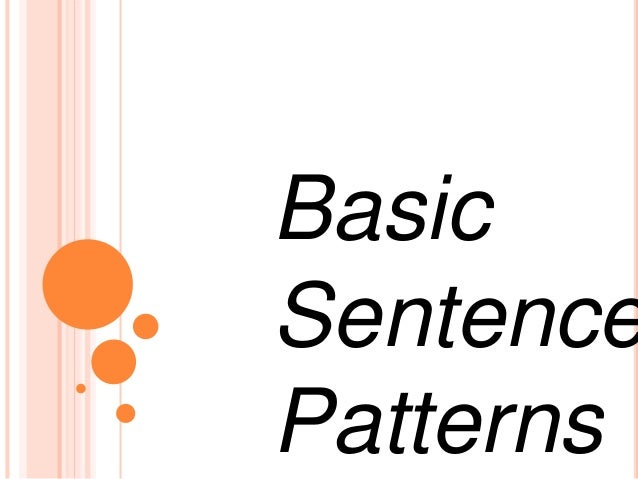Basic Sentence Patterns In English Pdf


Things happen. This basic sentence pattern can be modified by adding a phrase,, as well as other elements. This is true for all the sentence patterns that follow. ->Template Keren Buat Powerpoint here. Our employees work. ->My dog Frank eats. Things happen.
->Crazy things happen. Sentence Patterns #2 - Noun / Verb / Noun The next sentence pattern builds on the first pattern and is used with nouns that can take objects. John plays softball. The boys are watching TV. She works at a bank. Sentence Patterns #3 - Noun / Verb / Adverb The next sentence pattern builds on the first pattern by using an to describe how an action is done.
Thomas drives quickly. Anna doesn't sleep deeply. He does homework carefully.
The pattern of such sentence is: Subject – Verb – Direct Object – Preposition – Indirect Object Subject Verb Direct Object Preposition Indirect Object My friend His parents has sent bought a letter a computer to for me. Exercise 3 Rewrite each of the following sentences by placing the word in brackets before the indirect object. Simple Sentence. The most basic type of sentence is the simple sentence, which contains only one independent clause. Example: Burger King has the best hamburgers. A simple sentence can be as short as one word: Stop! TheSentence I: Sentence Patterns handout 1. A knowledge of basic sentence structure is necessary to write well.
Sentence Patterns #4 - Noun / Linking Verb / Noun This sentence pattern uses linking verbs to link one noun to another. Linking verbs are also known as equating verbs - verbs which equate one thing with another such as 'be', 'become', 'seem', etc. Sentence Patterns #6 - Noun / Verb / Noun / Noun Sentence pattern #6 is used with verbs that take both direct and.
I bought Katherine a gift. Jennifer showed Peter her car. The teacher explained the homework to Peter. Are the different type of words. They are put together to create sentence patterns in English. Here are the.
Learning parts of speech make understanding sentences easier. Noun Nouns are things, people, places, concepts ->computer, Tom, table, Portland, Freedom Pronoun Pronouns replace nouns in sentences. There are subject, object, and posessive pronouns ->he, I, them, our, its, us Adjective Adjectives describe things, people, places and concepts. Adjectives come before nouns. ->big, excellent, fun, tiny Verb Verbs are what people do, the actions they make. Verbs are used in many different tenses. ->play, visit, buy, cook Adverb Adverbs describe how, where or when something is done.
They often come at the end of a sentence. ->always, slowly, carefully Conjunction Conjunctions connect words and sentences. Conjunctions help us give reasons and explain. ->but, and, because, if Preposition Prepositions help us show the relationship between things, people and places. Prepositions are often just a few letters. ->in, at, off, about Interjection Interjections are used to add emphasis, show understanding, or surprise. Interjections are often followed by exclamation points.
->Wow!, ah, pow! There are a number of common sentence patterns used to write most sentences in English. The basic sentence patterns presented in this guide to sentence patterns will help you understand the underlying pattern in even the most complex English sentences.
Take this quiz to test your understanding of sentence patterns and parts of speech. What are the parts of speech of the words in italics in each sentence? • My friend lives in Italy.
• Sharon has a bicycle. • Alice has a banana and an apple. • He studies French at school. • Jason lives in New York. That sounds difficult. 3d Reconstruction Stereo Images Software.
• He lives in a big house. • Mary drove home quickly. Which sentence pattern does each sentence have? • Peter studies Russian. • I am a teacher. • I bought him a gift.
• Alice is happy. • My friends danced. • Mark spoke slowly. Answers to parts of speech quiz • verb • noun • conjunction • pronoun • preposition • interjection • adjective • adverb Answers to sentence pattern quiz • Noun / Verb / Noun • Noun / Linking Verb / Noun • Noun / Verb / Noun / Noun • Noun / Linking Verb / Adjective • Noun / Verb • Noun / Verb / Adverb.